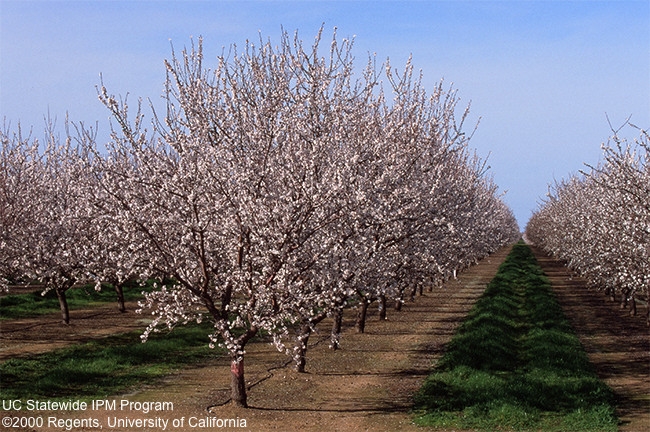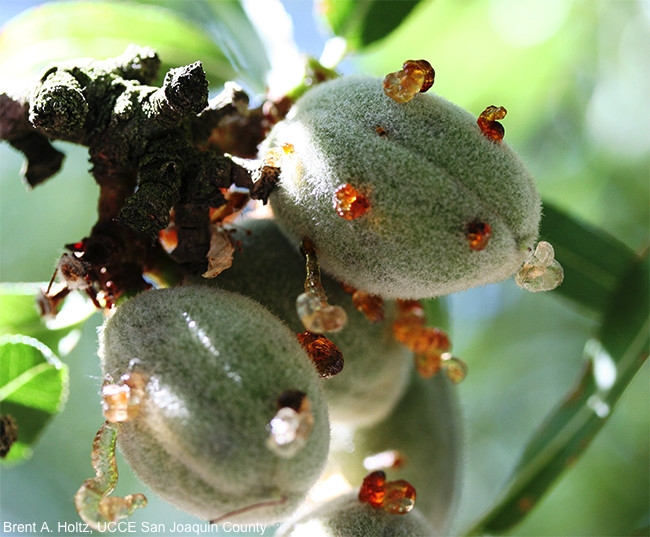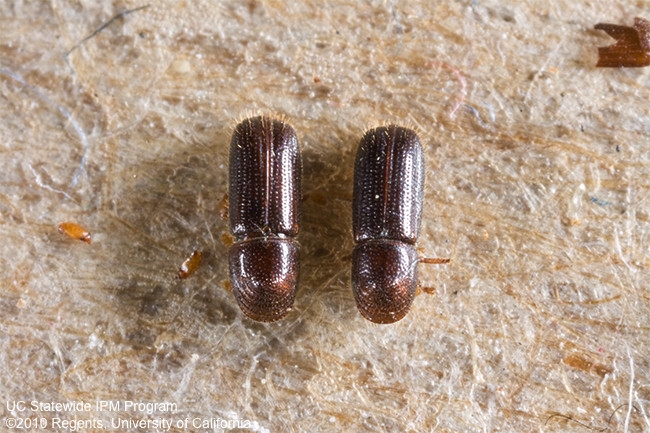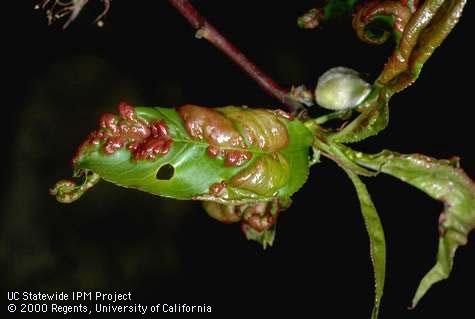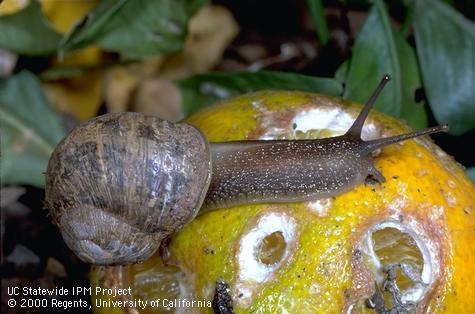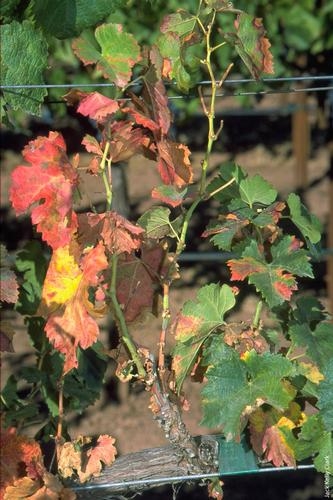Posts Tagged: pests
California trees are suffering under climate change and invasive pests
“There are lots of invasive pests everywhere because of global warming and the movement of plant materials in general,” said Philippe Rolshausen, UC Cooperative Extension subtropical tree specialist at UC Riverside.
Yellowing leaves, a thinning canopy and branch die-back are symptoms that the tree is sick. UC Master Gardeners, headquartered in UCCE county offices across the state, can provide free help, the article said.
Marantos listed possible reasons for common tree symptoms:
Yellow leaves: May be due to a lack of nutrients. A sudden jolt of fertilizer isn't the best solution. Homeowners often remove the best fertilizer and mulch for trees — their own fallen leaves.
Thinning canopies and branch die-back: May be the result of a soil-born disease, such a phytophthora, caused by excessive water. “Homeowners have a tendency to over-irrigate a tree that's not doing well, but soil-borne diseases actually thrive in wet soils, so that's making things even worse,” Rolshausen said. “Trees don't like standing water on their root systems because they can't breathe.”
Huanglongbing of citrus: Invested trees send up shoots of bright yellow leaves. Eventually, new leaves get twisted and mottled and the fruit stops ripening. The disease was first spotted in Southern California in the late 1990s and has since been detected in Los Angeles, Orange, San Bernardino and Riverside counties, according to a map prepared by University of California Agriculture and Natural Resources.
The Times article also recommended the UC Integrated Pest Management Program website to learn how to diagnose and control tree insects and diseases.
What's that in your cornmeal?
You're thinking about making Grandma's Southern Cornbread.
You head for your pantry. You remember that six months ago you purchased a bag of cornmeal from a local supermarket and that you immediately emptied the contents into a glass jar with a tight-fitting lid.
You open the airtight jar and notice something strange. It's moving. Moving? Moving? Yes! It's crawling with a transparent carpet of dozens of nearly microscopic critters.
What? First, what are they? If you're like me, you grab your camera--in this case, a Canon EOS 7D with an MPE-65mm lens that can magnify an insect five times its life size--and click the shutter.
You post the photo on BugGuide.Net and request an identification.
The entomologists all agree: They're booklice, Liposcelis bostrychophila.
- Class Insecta (Insects)
- Order Psocodea (Barklice, Booklice, and Parasitic Lice)
- Suborder Troctomorpha
- Family Liposcelididae (Booklice)
- Genus Liposcelis
- Species bostrychophila (Booklouse)
These Liposcelis bostrychophila, or "psocids" (pronounced "so kids"), are common pests in stored grains. They're usually unseen because they're about a millimeter long--about the size of a speck of dust--and are transparent to light brown in color. They're also wingless, but can they ever crawl!
Fact is, their name, "lice," is misleading. These tiny insects are not lice; they are not parasitic. And they're everywhere. They feed on flour, cereals, grits, molds, fungi, papers, books, pollen, dead insects and the like. In fact, you've probably unknowingly eaten them--or parts of them--in your pancakes, your oatmeal or maybe even your chocolate birthday cake.
Entomologist Jeff Smith, who curates the butterfly-moth collection at the Bohart Museum of Entomology at UC Davis, took one look at the photo and commented: "They're pretty thick in there!"
"Booklice can be scavengers and often feed on the bits of mold or fungi that grow on damp materials," Smith explained. "Very old, neglected food stuffs are also subject to them, and the key to prevention is to use food materials reasonably quickly and not store them for years, store them in a nice dry location and in airtight containers."
"They very well could have been in the food already when you bought it, but they're so common that you probably have some roaming around in the house all the time, just looking for something good to eat. They'll feed on dead bugs in window sills, stale pet foods, etc."
If you're worried about what's in your cornmeal, flour, oats, biscuit mix, cake mix and other stored foods, you can pop the contents in your oven at about 120° for a half hour, and then transfer them to an airtight container, Smith says. "Your food should be okay--albeit perhaps containing a few dead booklice. We had them in an old bag (paper) of rice one time, and in several packages of cornmeal mix that were forgotten in the back of our cupboard."
A UC Davis colleague said he's seen them crawling in his flour, but his wife made pancakes from them anyway. No issues. No problem. "Just protein!" he chortled.
And from another colleague: "I once had an entire case of instant grits. The grits were completely factory-sealed in unopened plastic bags. I opened the bags and the grits were poured into hot water, but they would not sink and mix with the water. Instead the grit floated on the top of the water. I opened a second bag and looked at the grits under my stereo microscope. Each and every grain of grit had two or three little six-legged creatures standing on each grit. These creatures were 100 percent transparent, the only color was in their bodies which was the same color as the grits they were eating. I opened every 100 percent factory-sealed bag, and every bag was contaminated in this matter."
"There is nothing new about insect contamination of grain products," she added. "Another personal experience was a biscuit mix. For no particular reason, I sifted the biscuit mix while making the batch of biscuits. After sifting several cups of biscuit mix, in the sifter screen there were 4 worm-like creatures about the diameter of a standard pencil and about an inch long. These worms were 100 percent transparent, each filled with the white biscuit mix. "Consider we all eat insects, spiders, and urine and feces of all sorts of animals."
We live in world where we all eat bugs, whether we know it or not. Sometimes we may not want to know!
Statistics indicate that the average American unknowingly eats one to two pounds of insects a year. But the U.S. Food and Drug Administration "has very specific tolerances for the amount of residue in food stuffs," said Lynn Kimsey, director of the Bohart Museum of Entomology and professor of entomology at UC Davis.
Want to know what the action level is? Check out this FDA document.
And the next time, you're yearning to make Grandma's Southern Cornbread, you might want to check for bugs first. Or maybe not. You might not want to know!
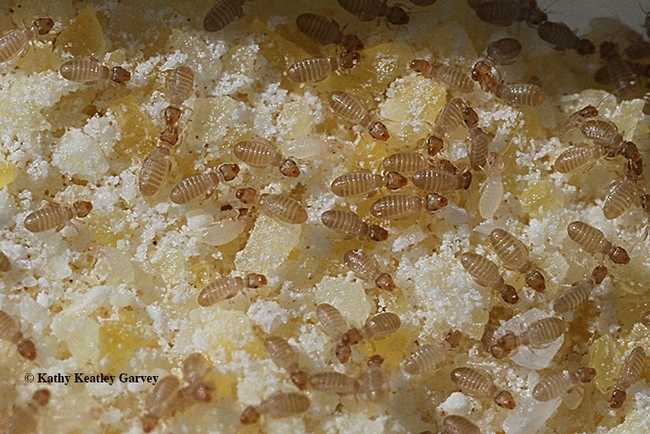
This image, taken with a Canon MPE-65mm lens, shows booklice, nearly microcopic insects, in cornmeal. The insects are about 1 millimeter long, or about the size of a speck of dust. (Photo by Kathy Keatley Garvey)
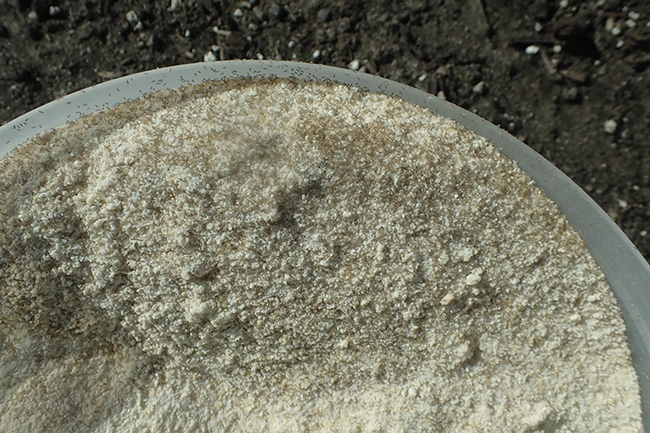
With the naked eye, booklice or Liposcelis bostrychophila, are nearly invisible. (Photo by Kathy Keatley Garvey)
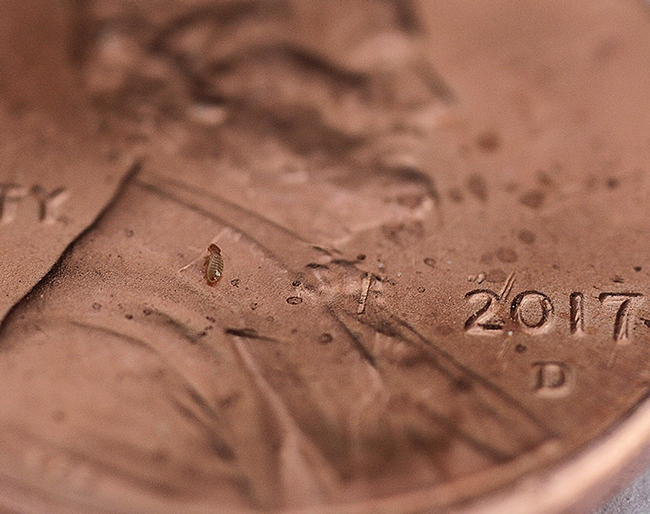
Find the booklouse! It's on this penny, magnified with the powerful Canon MPE-65mm lens. (Photo by Kathy Keatley Garvey)

Odds are that the flour, cornmeal and other stored products you buy in a grocery store contain insects parts or nearly microscopic insects. It's estimated that the average American unknowingly eats one to two pounds of insects or insect parts a year. (Photo by Kathy Keatley Garvey)
Almond and Walnut Pest Management Guidelines revised just in time for the holidays
‘Tis the season for baking lots of tasty treats. Breads, cookies, cakes, and candy are just a few that come to mind. What makes many of these treats so tasty is the addition of almonds or walnuts to the list of ingredients.
In California, we are lucky to be at the center of almond and walnut production. According to the California Department of Food and Agriculture's (CDFA's) latest Agricultural Statistics Review, more than 99 percent of the almonds and walnuts produced in the United States are grown in California.
Almond and walnut growers work tirelessly to supply enough nuts to not only satisfy domestic demand, but also for export. Worldwide, almonds rank as the largest specialty crop export. California is the top almond producer in the world, accounting for about 80 percent of all almonds grown. For walnuts, California ranks as the second largest producer in the world. To keep up with this demand, almond and walnut growers must be constantly aware of pests, diseases, and abiotic problems that can affect the tree and growing nuts.
The University of California Statewide Integrated Pest Management Program (UC IPM) has recently published revised Pest Management Guidelines for almonds and walnuts, helping growers prevent and manage pest problems with the most up-to-date information.
Revisions in the Almond Pest Management Guidelines include:
- A new section on bacterial spot, a new disease of almond in California found in the Sacramento and northern San Joaquin valleys
- A renamed section on fruit russeting, revised from the old powdery mildew section
- Significant revisions made to the management section of navel orangeworm, one of the major pests attacking California almonds
- Improvements on how to do dormant spur sampling section with easier-to-understand information on monitoring and thresholds
Revisions in the Walnut Pest Management Guidelines include:
- Updated information on the association between walnut twig beetle and thousand cankers disease
- New sections for Botryosphaeria and Phomopsis cankers, branch wilt, and paradox canker
- Significant changes to the walnut husk fly management section
Both the almond and walnut revised Pest Management Guidelines also include updated information on fungicide efficacy, weed management, and vertebrate management.
Authored by University of California specialists and advisors, the Pest Management Guidelines are UC's official guidelines for monitoring and managing pests in California crops. For more information on pest management in these or other crops, visit the UC IPM website.
Top 10 pests in gardens and landscapes and how to control them
Download the free booklet at the bottom of the page!
1. Ants
Most people deal with ants around their home at some point. Because most ants live outdoors, focus efforts on keeping ants from entering buildings by caulking entryways. Follow good sanitation practices to make your home less attractive to ants. Spraying ants inside the home will not prevent more ants from entering. Use baits to control the ant colony. Pesticide baits work by attracting worker ants who then take the poison back to the nest where the entire colony, including queens, can be killed. In the landscape, ants protect honeydew-producing pest insects from predators, so use sticky barriers or insecticide baits to keep ants out of trees and shrubs.
- Find out more at http://www.ipm.ucanr.edu/QT/antscard.html
2. Aphids
Aphids can curl leaves and produce sticky honeydew, but they rarely kill plants and you usually can wash them off with water. When aphid numbers get high, natural enemies such as lady beetles (lady bugs), lacewings, syrphid fly larvae, soldier beetles and others frequently feed on them, eliminating the need for pesticides. Protect these good bugs by avoiding the use of insecticides that can be toxic to a broad variety of insects. Ants protect aphids from these natural enemies, so keep ants away from your garden as well. When pesticides are necessary, use less toxic products such as insecticidal soaps and oils.
- Learn more about controlling aphids here: http://www.ipm.ucanr.edu/QT/aphidscard.html
3. Asian citrus psyllid and Huanglongbing disease
The Asian citrus psyllid (ACP) and the deadly bacterial disease it spreads, Huanglongbing (HLB), threaten citrus trees in backyards and on farms. There is no cure or effective control method for HLB disease. All types of citrus—including oranges, grapefruit, lemons, and mandarins—are affected as well as a few closely related ornamentals. ACP and HLB have already devastated the Florida citrus industry, and now that it is in the Western U.S. it is threatening the California citrus industry as well.
- See where the outbreaks are in California with our helpful Asian citrus psyllid website: http://ucanr.edu/sites/ACP/Distribution_of_ACP_in_California/
- Contact your agricultural commissioner's office, or call the California Department of Food and Agriculture (CDFA) Exotic Pest Hotline at 1-800-491-1899 to confirm a find. Learn more about ACP here: http://www.ipm.ucanr.edu/QT/asiancitruscard.html
4. Gophers
Gophers are small burrowing rodents that feed on roots of many types of plants. A single gopher can ruin a garden in a short time, and gopher gnawing can damage irrigation lines and sprinkler systems. In lawns, their mounds are unsightly and interfere with mowing. Early detection is critical to prevent damage. Use both traps and underground fencing to manage gopher problems. Toxic baits are available but can pose threats to wildlife, pets, and children, especially in backyard situations.
- Learn more about protecting your garden and landscape from gophers here: http://www.ipm.ucanr.edu/QT/gopherscard.html
5. Leaf-feeding caterpillars
Caterpillars, which are the larvae of butterflies and moths, damage plants by chewing on leaves, flowers, shoots, and fruit. Caterpillars in fruit or wood can be difficult to manage because they are hidden most of their life and can cause serious damage even when numbers are low. However, many plants, especially perennials, can tolerate substantial leaf damage, so a few leaf-feeding caterpillars often aren't a concern. Handpicking and beneficial predators and parasites often provide sufficient control. Look for feeding holes, excrement, webbed or rolled leaves, caterpillars, eggs, and good bugs.
- Learn more here:http://www.ipm.ucanr.edu/QT/lfcaterpillarscard.html
6. Peach leaf curl
Peach leaf curl is a fungal disease that affects only peach and nectarine trees. Distorted, reddened foliage in the spring is a distinctive symptom. New leaves and shoots thicken and pucker and later may die and fall off. An infection that continues untreated for several years can lead to a tree's decline. To prevent peach leaf curl, treat peach and nectarine trees with a copper fungicide every year after leaves fall. After symptoms appear in the spring, any treatment will not be effective. When planting new trees, consider buying peach tree varieties that are resistant to the disease.
- To learn more about preventing peach leaf curl click here: http://www.ipm.ucanr.edu/QT/peachleafcurlcard.html
7. Rats
Rats eat and contaminate food, garden produce, and fruit, and transmit diseases to humans and pets. Manage rats by removing food and shelter, eliminating entryways into buildings, and trapping. Snap traps are the safest, most effective, and most economical way to trap rats. For Norway rats, place traps close to walls, behind objects, in dark corners, and in places where you have found rat droppings. For roof rats, place traps in off-the-ground locations such as ledges, shelves, branches, fences, pipes, or overhead beams. Ensure traps are out of reach of children and pets.
- Learn more about preventing and controlling rats here: http://www.ipm.ucanr.edu/QT/ratscard.html
8. Scales
Scale insects suck plant juices and are pests of many trees and shrubs. Infestations can cause yellowing or premature dropping of leaves, sticky honeydew, and blackish sooty mold. Plant parts can distort or die back, depending on the species and abundance of scales. Most plants tolerate low to moderate numbers of scales. Provide plants with proper cultural care, especially irrigation. Encourage scale predators such as lady beetles or lacewings and look for parasite emergence holes in scale covers. Use sticky barriers or insecticide baits to selectively control scale-tending ants. Consider replacing problem-prone plants because most scales are highly specific to certain plants.
- Learn more about controlling scale populations here: http://www.ipm.ucanr.edu/QT/scalescard.html
9. Snails and slugs
These slimy mollusks emerge from hiding at night and chew holes in leaves and flowers of many succulent garden plants and fruit. Management requires a vigilant and integrated approach that includes eliminating moisture and hiding spots, trapping, setting up barriers, and handpicking. Regularly remove snails from shelters you can't eliminate such as low ledges on fences, undersides of decks, and meter boxes. Place traps in your garden and dispose of trapped snails and slugs daily. Reduce moist surfaces by switching to drip irrigation or watering in the morning rather than later in the day. Consider snail-proof plants such as impatiens, geraniums, begonias, lantana, nasturtiums, and many plants with stiff leaves and highly scented foliage such as sage, rosemary, and lavender.
- Learn more about controlling snails and slugs with and without pesticides in your garden here: http://www.ipm.ucanr.edu/QT/snailsslugscard.html
10. Weeds in landscapes
Prevent weed invasions in new beds with good site preparation. Keep weeds out with an integrated program that includes competitive plants, mulches, and hand removal. Be particularly vigilant about removing aggressive perennial weeds. You rarely should need herbicides in established landscape plantings. Mulches prevent weed seed germination by blocking sunlight. Remove small weeds by hand before they flower and set seed. Use shallow cultivation or hoeing to remove annual weeds from ornamental plantings. Only use herbicides for special-problem situations before establishing new plantings or for difficult-to-control perennial weeds.
- Learn more about controlling weeds in your landscape here: http://www.ipm.ucanr.edu/QT/landscapeweedscard.html
To see all of the University of California's Statewide Integrated Pest Management Program's information on home, garden, and landscape pests, visit http://www.ipm.ucanr.edu/PMG/menu.homegarden.html
For other short pest “Quick Tips” like the ten above, see http://www.ipm.ucanr.edu/QT/
To read even more in-depth, peer-reviewed information on many other common home and landscape pests in California, see the Pest Notes series at http://www.ipm.ucanr.edu/PMG/PESTNOTES/index.html
Download your free UC IPM Quick Tips Booklet of the Top Ten Pests in Gardens and Landscapes and How to Control Them with the link below!
From superweeds to Pierce’s disease: California Agriculture reports on fighting diseases and pests
California agriculture is unique and diverse — and so are its pest and disease problems. Take herbicide resistance. While in the rest of the country herbicide resistance problems center on broadleaf weeds in corn, soy and wheat, in California the greatest problems are found in grasses and sedges in orchards, vineyards and rice fields. Herbicide resistance among California crops also varies widely. In vegetable fields, for instance, resistance is not a serious problem and is unlikely to become one.
An article in the current issue of California Agriculture, the peer-reviewed journal from the University of California Agriculture and Natural Resources, examines the spread of herbicide-resistant weeds in California and shows how UC researchers and Cooperative Extension specialists are helping growers to understand and manage the factors that drive it.
Five more articles in this special issue of California Agriculture highlight the work of UC Agriculture and Natural Resources on pests and diseases that threaten the state's people, agriculture and natural resources. The commitments to research and outreach profiled in the issue include the Endemic and Invasive Pests Strategic Initiative, the UC Statewide IPM Program and several successful collaborations with regulatory agencies and the agricultural community.
Excluding pests and pathogens
Diagnostics in animal health: How UC helps exclude and minimize impact of livestock pathogens
Whether it's pinkeye, bluetongue or poisonous plants, UC maintains a strong network of laboratories and field experts to protect livestock health in California.
Regional alliances of federal, state and university plant diagnostic labs work together to identify and control disease spread.
Managing newly established pests
Growers, scientists and regulators collaborate on European grapevine moth program
A regulatory program coordinated by government agencies, scientists and growers successfully contained an infestation that threatened California vineyards.
Cooperative efforts controlled spread of Pierce's disease and found genetic resistance
The 1999 arrival in California of a new Pierce's disease vector, the glassy-winged sharpshooter, posed a major new threat to California vineyards and orchards. A 15-year collaborative effort has successfully contained the sharpshooter and led to major improvements in our understanding of the biology of Pierce's disease, including promising advances in the development of disease-resistant grapevine lines.
Maintaining long-term management
Herbicide-resistant weeds challenge some signature cropping systems
Little or no crop rotation and limited herbicide options have contributed to the rise of herbicide-resistant weeds in orchards, vineyards and rice fields.
Over 35 years, integrated pest management has reduced pest risks and pesticide use
The UC Integrated Pest Management Program helps provide management solutions for invasive pests that destabilize IPM programs in agricultural and urban landscapes.
E-edition research article
The cost of the glassy-winged sharpshooter to California grape, citrus and nursery producers
The spread of the invasive insect in the late 1990s led to increased costs and changes in agricultural practices for grape, citrus and nursery producers.
These articles and the entire October-December 2014 issue are available at http://californiaagriculture.ucanr.edu.
California Agriculture is the University of California's peer-reviewed journal of research in agricultural, human and natural resources. For a free subscription, go to http://californiaagriculture.ucanr.edu or write to calag@ucanr.edu.
University of California Agriculture and Natural Resources is the bridge between local issues and the power of UC research. UC ANR's advisors, specialists and faculty bring practical, science-based answers to Californians. Visit ucanr.edu to learn more.


